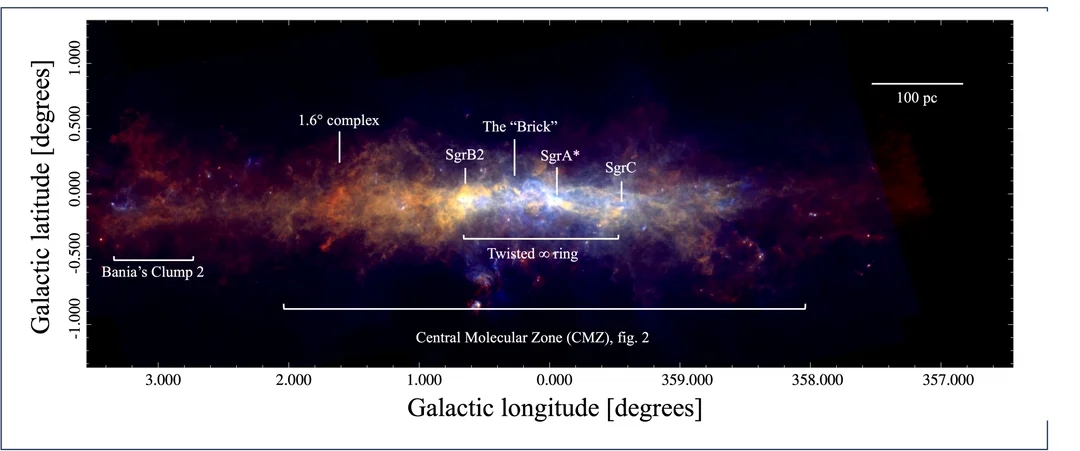
Unveiling the Secrets of the Milky Way’s Core and Early Planet Formation: New 3D Models and ALMA Observations
The cosmos is vast and mysterious, holding secrets to how stars are born and galaxies evolve. Recent breakthroughs in astronomical research are shedding light on some of these fundamental processes, from the heart of our own Milky Way galaxy to the formation of planets around distant stars. Two major studies, utilizing advanced observational techniques, are providing unprecedented detail about the Central Molecular Zone (CMZ) of the Milky Way and protoplanetary disks, the birthplaces of planets. These findings significantly enhance our understanding of galactic dynamics and planetary formation.
Mapping the Milky Way's Chaotic Core in 3D
At the center of our galaxy lies Sagittarius A*, a supermassive black hole with the mass of four million suns. Surrounding it is the CMZ, a region of extreme conditions filled with interstellar matter and powerful magnetic fields. A team of researchers, led by Associate Professor Cara Battersby at UConn's Milky Way Laboratory, has created a comprehensive 3D model of this zone. This model aims to map the gas flows either orbiting the galaxy's center or feeding the supermassive black hole. The challenge lies in observing the CMZ from our vantage point within the galaxy, obscured by dense gas, dust, and stars.

The researchers compiled a catalog of molecular clouds, measuring their physical properties such as mass, temperature, and velocity. By analyzing this data, they could determine which clouds are moving towards the black hole and which are simply orbiting it. Their work revealed that previous models lacked the complexity needed to accurately represent the dynamics of the CMZ. A new, simpler ellipse model has shown promising results, and the team is now developing a more refined model that incorporates cloud positions relative to Sagittarius A*.

According to Dani Lipman, a PhD student involved in the research, releasing their code promotes collaboration within the scientific community, providing valuable resources for new scientists and students. This research marks a significant advancement in understanding the workings of our galaxy's core and the gas flows that shape the environment around Sagittarius A*.
Detailed Observations of Protoplanetary Disks: A New Era in Planet Formation Study
Beyond our galaxy, understanding how planets form is another key question in astronomy. An international team led by Richard Teague, the Kerr-McGee Career Development Professor at MIT, has conducted detailed observations of 15 protoplanetary disks—the swirling clouds of gas and dust around young stars where planets are born. Using the Atacama Large Millimeter/submillimeter Array (ALMA) in Chile, the team obtained the most sensitive and detailed images of these disks to date.

“The new approaches we've developed to gather this data and images are like switching from reading glasses to high-powered binoculars—they reveal a whole new level of detail in these planet-forming systems,” says Teague. The observations revealed a stunning range of structures in the gas morphology, including gaps, rings, and spirals. These structures provide clues about the dynamics within the disks.
One notable finding concerns the role of vortices in planet formation. Vortices, or localized perturbations in the gas, can concentrate dust, making it easier for dust grains to clump together and form planetary cores. Lisa Wölfer, a postdoc at MIT, emphasized the importance of gas dynamics in confirming the presence of vortices. The team's models initially failed to explain the observed data, prompting a reevaluation and the development of more complex models incorporating gas motion. The enhanced data has been made public, and is expected to be productive for years to come.
A Glimpse into the Future of Astronomical Research
Both the 3D model of the CMZ and the ALMA observations of protoplanetary disks represent significant steps forward in our understanding of the universe. By exploring our own galactic center and the processes of planet formation, scientists are piecing together the puzzle of cosmic evolution. What new insights will emerge as astronomers continue to analyze these data sets, and how will they reshape our understanding of the universe? Share your thoughts and theories in the comments below!